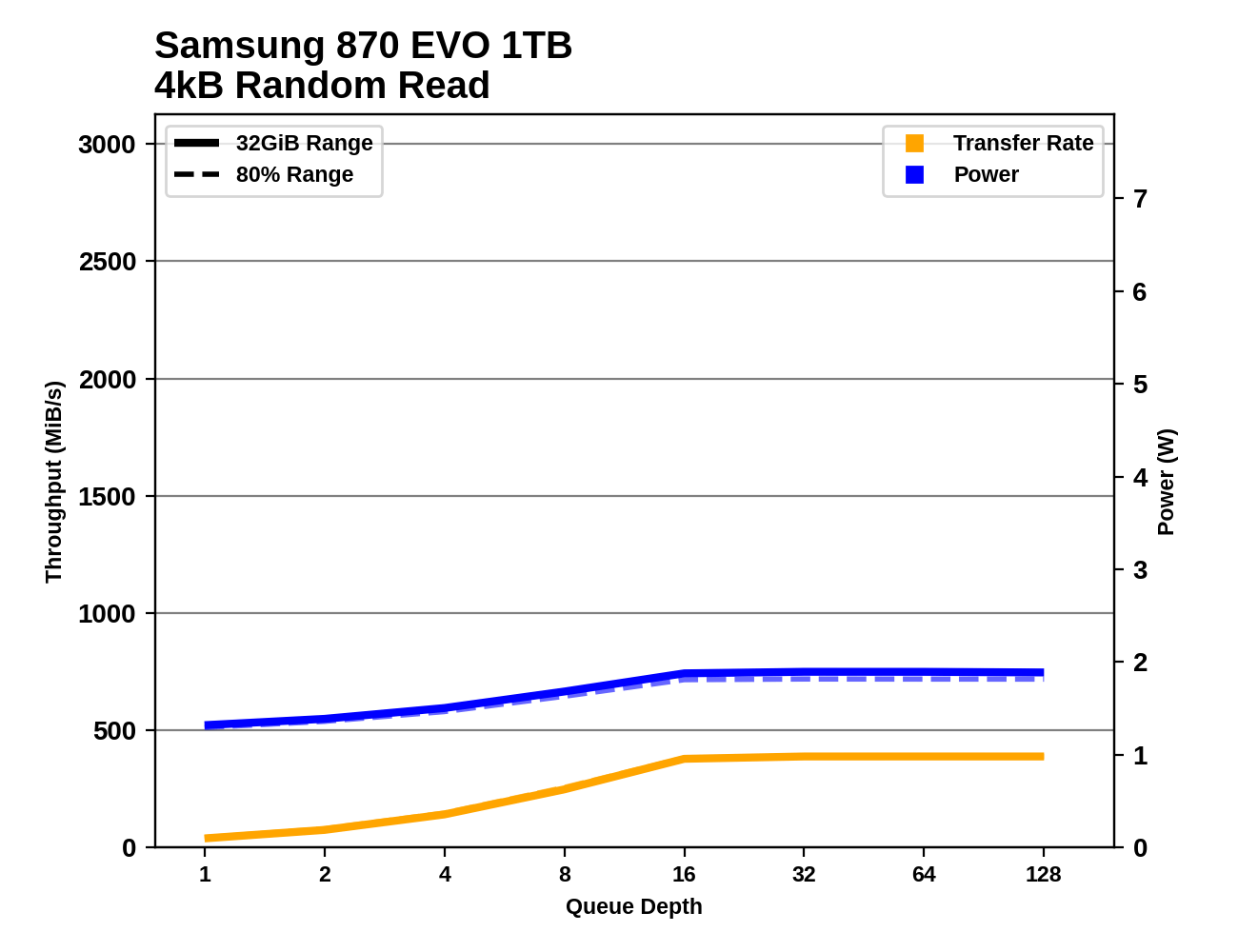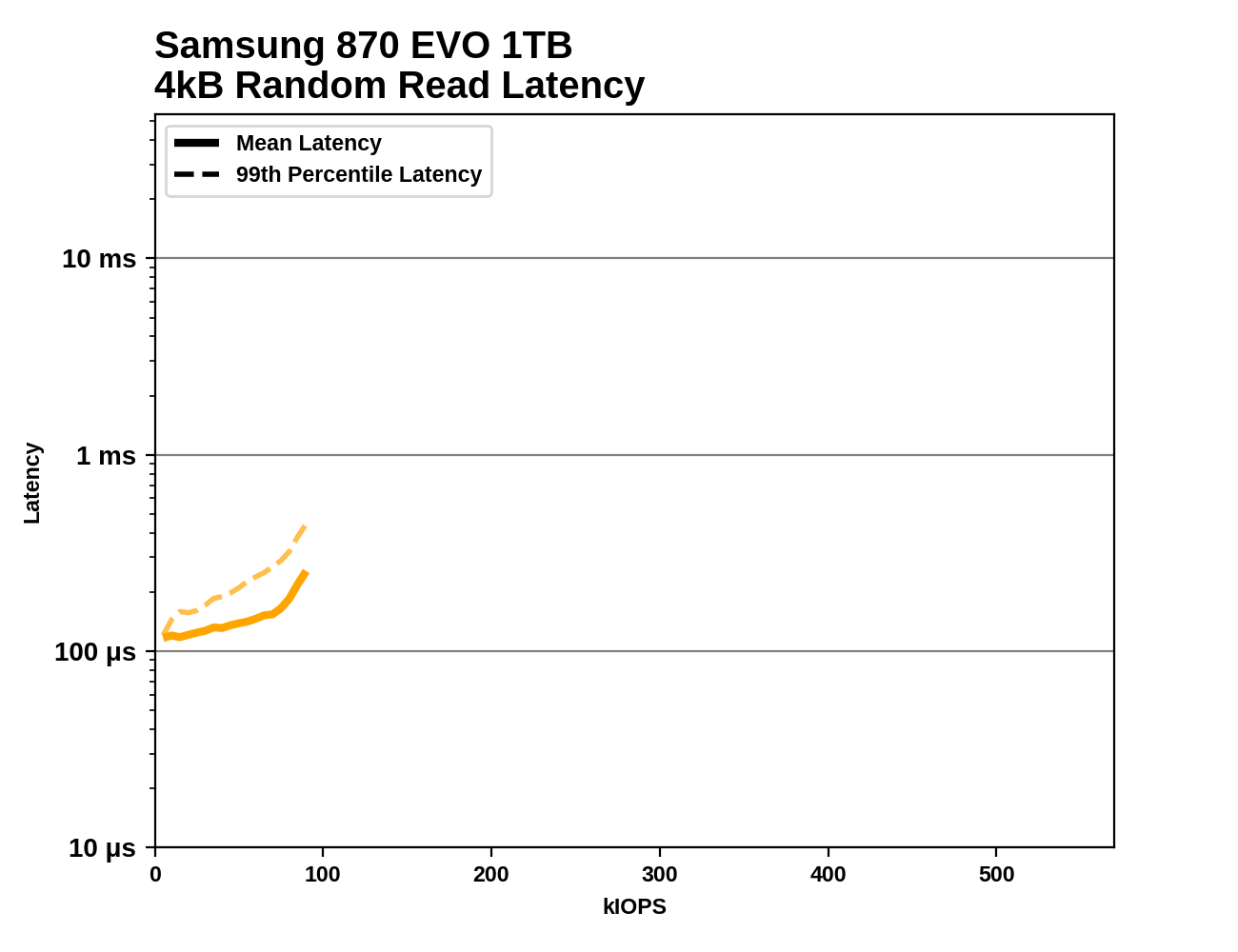The Samsung 870 EVO (1TB & 4TB) Review: Does the World Need Premium SATA SSDs?
by Billy Tallis on February 17, 2021 8:00 AM ESTBurst IO Performance
Our burst IO tests operate at queue depth 1 and perform several short data transfers interspersed with idle time. The random read and write tests consist of 32 bursts of up to 64MB each. The sequential read and write tests use eight bursts of up to 128MB each. For more details, please see the overview of our 2021 Consumer SSD Benchmark Suite.
 |
|||||||||
| Random Read | Random Write | ||||||||
| Sequential Read | Sequential Write | ||||||||
Our burst IO tests show little to no performance differences between the Samsung 870 EVO and other top SATA SSDs. The 1MB sequential transfers are already hitting the SATA throughput limits even at QD1, and the 4kB random IOs are at best marginally improved over Samsung's previous generation. Samsung's slight improvement to random read latency is enough to catch up to Micron's as shown by the Crucial MX500, but a 10% gain hardly matters when NVMe drives can double this performance.
Sustained IO Performance
Our sustained IO tests exercise a range of queue depths and transfer more data than the burst IO tests, but still have limits to keep the duration somewhat realistic. The primary scores we report are focused on the low queue depths that make up the bulk of consumer storage workloads. For more details, please see the overview of our 2021 Consumer SSD Benchmark Suite.
 |
|||||||||
| Random Read | Random Write | ||||||||
| Sequential Read | Sequential Write | ||||||||
On the longer synthetic tests that bring in some slightly higher queue depths, the improved random read performance of the 870 EVO is a bit more clear. In one sense it is impressive to see Samsung squeeze a bit more performance out of the same SATA bottleneck, but we're still talking about small incremental refinements where NVMe enables drastic improvements. Aside from random reads, the 870 EVO's performance improvements are exceedingly minute and it should be considered essentially tied with most other recent mainstream TLC SATA drives.
 |
|||||||||
| Random Read | Random Write | ||||||||
| Sequential Read | Sequential Write | ||||||||
Power consumption is one area where Samsung could theoretically offer more significant improvements despite still being constrained by the same SATA interface, but the 870 EVO doesn't really deliver any meaningful improvements there. The 4TB model is consistently a bit less efficient than the 1TB model on account of having more memory to keep powered up, but when comparing the 1TB model against its predecessor and competing drives there's nothing particularly noteworthy about the 870 EVO. SK hynix's Gold S31 has a modest efficiency advantage for random IO while Samsung is technically the most efficient of these SATA drives for sequential IO.
 |
|||||||||
| Random Read | |||||||||
| Random Write | |||||||||
| Sequential Read | |||||||||
| Sequential Write | |||||||||
The queue depth scaling behavior of the 870 EVOs is almost identical to the 860 EVOs and still quite typical for mainstream SATA drives. For random reads the 870 EVOs saturate around QD16, while for random writes QD4 suffices. On the sequential IO tests there's only a small performance gain from QD1 to QD16, and the more interesting question is how stable performance is through the rest of the sequential tests. The 1TB 870 EVO seems to run out of SLC cache a bit earlier than the 860 EVO when the sequential write test is running on an 80% full drive, but the 4TB model has plenty of cache to finish out that test at full speed.
Random Read Performance Consistency
This test illustrates how drives with higher throughput don't always offer better IO latency and Quality of Service (QoS), and that latency often gets much worse when a drive is pushed to its limits. This test is more intense than real-world consumer workloads and the results can be a bit noisy, but large differences that show up clearly on a log scale plot are meaningful. For more details, please see the overview of our 2021 Consumer SSD Benchmark Suite.
 |
|||||||||
Consistent with most of our other read performance tests, the Samsung 870 EVO shows slightly better average and 99th percentile random read latencies than most of its SATA competition. Even some of the entry-level NVMe drives that can deliver higher random read throughput than is possible for the 870 EVO still have clearly higher latency across most or all of the throughput range that the 870 EVO can cover. A QLC-based or DRAMless TLC NVMe SSD can potentially offer far higher throughput than any SATA SSD, but clearly beating the 870 EVO on both throughput and latency requires stepping up to a more mainstream NVMe design with DRAM and TLC NAND.










136 Comments
View All Comments
Krimzon - Wednesday, February 17, 2021 - link
Early USB standards were uni directional. 3 and 4 are full duplex.PixyMisa - Thursday, February 18, 2021 - link
10Gbps USB is already twice as fast as 6Gbps SATA because it uses more efficient encoding. 20Gbps USB is available right now, and 40Gbps is part of the USB 4 spec though I don't know how widespread support for it is.Wereweeb - Wednesday, February 17, 2021 - link
No need to replace SATA, it will die by itself. What we need is high-end consumer motherboards to get U.3.Billy Tallis - Wednesday, February 17, 2021 - link
U.3 is probably only going to be around for two or three product cycles. It's very much a stopgap solution to unify U.2 and SAS, both of which are already on the way out in favor of EDSFF.Wereweeb - Thursday, February 18, 2021 - link
Great! Then they can introduce it for consumers to have 2.5" drives again.Leeea - Wednesday, February 17, 2021 - link
The nice thing about SATA SSDs is they tend to just work. Pull one out of one system, stick them in another, and it can boot.The pci drives seem to be a lot more fussy with that.
danbob999 - Wednesday, February 17, 2021 - link
Not really. All drives (IDE / SATA / NVMe / USB / Whatever) pretty much just work. The problem is the OS may not boot. When switching to a different protocol (say SATA to NVMe), you increase chances it won't boot.Linux is easier to get to boot than Windows when changing the drive to a different system.
Jorgp2 - Wednesday, February 17, 2021 - link
Nah, it all comes down to EFI vs MBR.MBR systems just look for a boot partition and boot it, EFI actually stores the location on the motherboard flash.
WaltC - Wednesday, February 17, 2021 - link
Agreed...;) I might say "UEFI vs. Legacy," though. And much of it has to do with the knowledge, experience, and skill of the computer operator...! No question about that. (It's actually MBR vs. GPT--GPT is better. All of my SATA HDDs are formatted GPT, etc. I have no MBR-formatted drives.)The list of NVMe drives here is curious. Where is the 980 Pro from Samsung?--been selling for a while now--one of several PCIe4 NVMe drives available. Makes me question when this article was actually written....? It seems incomplete or out of date. Samsung is a chip company no longer in the business of making platter drives (last I looked, anyway-do they still sell the Spinpoints?), so it's natural for them to sell SSDs of varying types, sizes, and prices, imo.
Billy Tallis - Wednesday, February 17, 2021 - link
I deliberately chose not to include 980 PRO results in the graphs for this review, because that's a silly comparison to make against a SATA drive. But if you really care, you can use Bench: https://www.anandtech.com/bench/product/2724?vs=27...